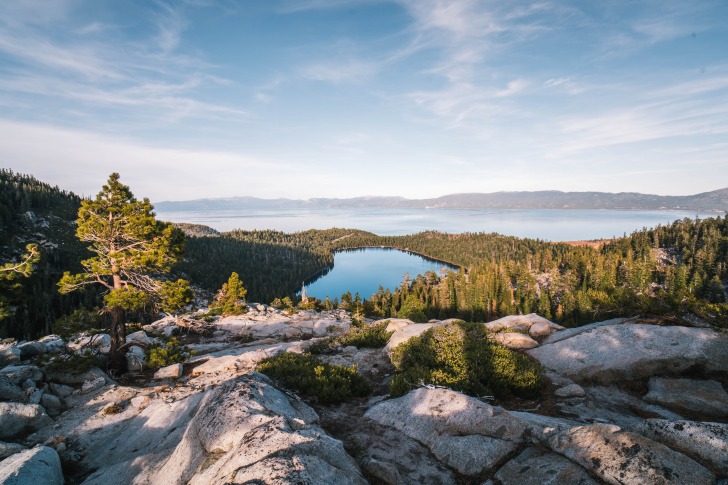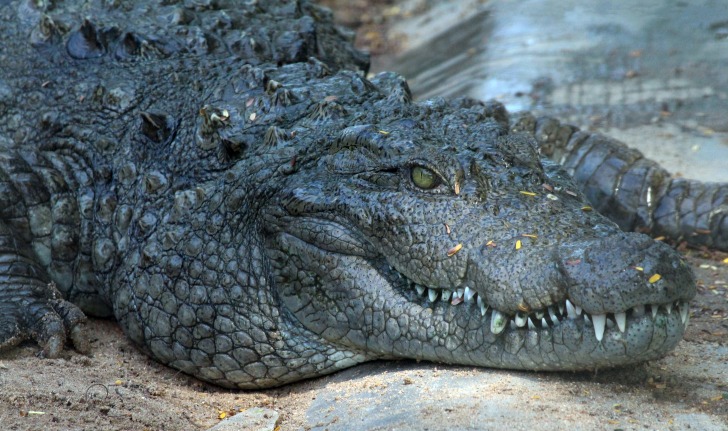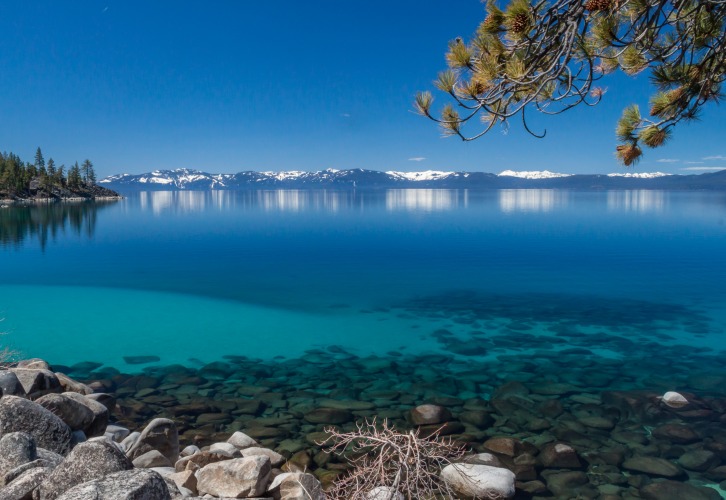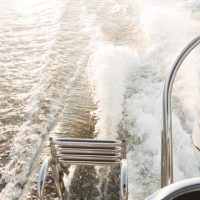Lake Tahoe is one of the largest lakes in California.
Located in the northwestern part of the state, it is home to hundreds of different species of fish, birds, mammals, and reptiles.
Typically, alligators are found in the southeastern part of the U.S.
However, do you have to worry about alligators swimming in Lake Tahoe?

Contents
So… Are There Alligators in Lake Tahoe?
There are usually no alligators in Lake Tahoe.
Alligators are not native to California.
Instead, you’ll find them in some of the southern states such as Florida, Louisiana, and Texas.
Most of the time, alligators don’t go further west simply because it is not the kind of habitat that they thrive in.
If you see an alligator in Lake Tahoe, it will be EXTREMELY RARE.
There are a few reasons why sightings are rare:
- They are not native to the area
- They cannot survive in the colder weather
- They are typically removed as soon as they are spotted
If you happen to notice an alligator, it is likely because someone was keeping one as a pet.
Then, it got too large, and they released it into the community.
The alligator went to the nearest body of water where it could survive – and that would be Lake Tahoe.
There is a lot of different fish including salmon and trout that are extremely attractive to alligators.
During the summer, it could easily survive due to the warmth as well as the available food sources.
Although alligators have the ability to grow quite large, you won’t find large ones in California.
It’s simply because they are usually captured long before they have a chance to grow into a full-sized adult.
Adult male gators can reach 11 to 12 feet in length while females can reach around 8 to 9 feet.
If you listen to any of the stories over the years of the occasional gator being caught in or around Lake Tahoe, they are typically no larger than three feet.
That means that even if you happened upon one, they likely would not be able to do much damage.
Alligator Species in Lake Tahoe
It’s important to understand the various types of reptiles that are within the order of Crocodilia.
This includes alligators, crocodiles, caimans, and gharial.
There are only two species that are native to the U.S. – the American Alligator and the American Crocodile.
Neither will be located in Lake Tahoe simply because they aren’t native.
If you do come across an American Alligator in the Lake Tahoe area, it was set loose because someone was illegally keeping one as a pet.
There are some places where you can see the various alligator species in Lake Tahoe, CA.
You will simply have to see them in captivity.
Often, the animals will “visit” based on what the zoo or sanctuary has or trades for the display of its visitors.
That means that you can see a variety of different animals.
If you’re eager to see a live alligator, you’ll want to check out these places in the Lake Tahoe area:
- Sierra Safari Zoo
- Animal Ark
- Andelin Family Farm
- Bartley Ranch Regional Park
- Crooked Creek Acres
If you see any gators (or crocodiles) outside of these locations, you should definitely call the California Department of Fish and Wildlife to report where you spotted the reptile so that it doesn’t cause harm to you or anyone else – or anything else within the ecosystem.
Is It Safe to Swim in Lake Tahoe?
Lake Tahoe offers an incredible amount of swimming throughout the year.
It is popular for not only swimming but also boating and other water-based activities.
Most recommend that you locate a sandy beach so that you can start shallow – and the waters will be warmer.
Some of the top beaches for you to swim in Lake Tahoe include:
- Sand Harbor Beach (North Shore)
- Kiva Beach (South Shore)
- Baldwin Beach (South Shore)
- Lester Beach (West Shore)
You won’t have to worry about alligators attacking you while you are swimming around.
Typically, there are no predators to worry about when you enter the water.
The biggest concerns if you are going to swim in Lake Tahoe are the high elevation as well as the weather.
The higher altitude can lead to dehydration and even require you to take in deeper breathing so that you can be comfortable.
As you start to get into the late fall and winter months, the water will start to get a lot colder, especially a foot or two below the surface.
You will want to make sure you read plenty of reports to find out what the weather is going to be like so that you can determine whether it is too cold to go swimming – otherwise, you could find yourself in freezing water and unable to swim out.
It is also not uncommon to see waves develop throughout Lake Tahoe because of the changing wind.
Again, check the weather so that you can be prepared for what you may encounter when you are swimming in this large body of water.

Interesting Alligator Facts in Lake Tahoe
There are quite a few interesting things about Lake Tahoe, particularly as it pertains to alligators.
Lake Tahoe is the largest freshwater lake within the Sierra Nevada, which means that alligators have the ability to live in it.
Alligators don’t have salt glands as crocodiles do, so they can’t tolerate high salinity.
The reason that most herpetologists say that an alligator wouldn’t be able to survive in Lake Tahoe is because of the cold weather.
Alligators actually need to live in temperatures above 40° so that they can remain active.
If the weather drops below 70°, they don’t have the ability to digest food.
Winter weather in Lake Tahoe can easily get as low as 25° on a regular basis, making it so that alligators would not be able to digest food or remain active.
Exposure to continuous cold water would result in their death.
Within the past 10 years, there have been absolutely no alligators spotted in Lake Tahoe.
The nearest spotting is in Elk Grove Lake.
Lake Tahoe is a quarter of a mile deep in some areas, so there are sorts of mysterious creatures.
However, there still aren’t any alligators lurking, no matter how far scuba divers have investigated.
Alligators vs. Crocodiles
You’ll find that there are a lot of differences between alligators and crocodiles.
While they are both crocodilian and cold-blooded, you’ll want to know how to tell them apart in the event that you find them in the wild.
Alligators are going to have stumpier legs and gray/black scales along their back.
You won’t be able to see their teeth when their mouths are closed, but you will notice that they have an overbite.
Their snouts are rounded or U-shaped, too.
Crocodiles, in contrast, have longer legs and green/brown scales along their back.
You will be able to see some of their teeth when their mouths are closed, and they will also have a more pointed snout.
Neither the alligator nor the crocodile is native to California, so you shouldn’t be seeing either in the wild.
Both the American alligator and the American crocodile-like stick with the warmer weather, which is something that is not offered in the Lake Tahoe area year-round.
American alligators are found throughout the southeast, though the American crocodile is typically only found in Florida as well as in Mexico and South America.
3 Safety Tips for Swimming in Alligator-Infested Waters
While you won’t be swimming in alligator-infested waters if you choose to wade into Lake Tahoe, there may be instances where you will be in such waters. 9 out of the top 10 alligator-infested water in the U.S. are in Florida – and all of those are identified as such so that you can avoid them (or use extreme caution).
If you do find yourself in any kind of alligator-infested waters, there are a few safety tips to follow:
- Don’t enter the water alone: Always have others with you when you enter the water so that there is someone who can call for help or come to your aid in the rare event of an attack.
- Know how to fight: While the hope is that you never have to fight an alligator, there are things that you can do. Run whenever you can. Otherwise, smack it on the snout if it does capture you. It is also possible to gouge the eyes.
- Read all warnings: There are likely going to be warnings about when it is safe versus unsafe to go into the water. If it is a mating season or there’s a large number of gators in the water, it’s best to stay away.
Summary
Alligators can be quite fierce reptiles, especially when they are provoked.
This is why it’s better to let them be if you encounter them in the wild.
The good news is that when you are in Lake Tahoe, you don’t have to worry about them.
Due to the northwestern location of Lake Tahoe, it is highly unlikely for alligators to wander up there.
Even if they are set free by someone who was illegally keeping them as a pet, the alligator is not likely to survive the winter – which also ensures that alligators will never get too large.
In the rare event that you do encounter an alligator in the wild throughout Northern California, they will be small.
If they do attack, they likely won’t hurt you too badly.
If you do want to see alligators or even crocodiles, you can see plenty of them in captivity throughout the various zoos and sanctuaries around Lake Tahoe and the rest of northern California.
Frequently Asked Questions
Will an alligator attack as soon as it sees a human?
An alligator typically won’t leave the water if it sees a human.
Alligators will stay close to the water, so if it comes after you, it sees you as a threat, especially if it is nesting where you are approaching.
What are the biggest problems with swimming in Lake Tahoe?
You won’t have to worry about alligators.
Instead, you will have to worry about the weather – and that includes cold water, shifting winds, and even the higher altitude.
How many people die every year due to alligator attacks?
Every fatal attack from an alligator has occurred in the southeast where they are native.
Typically, there are no more than four or five in a year – and often, it is less than that.











